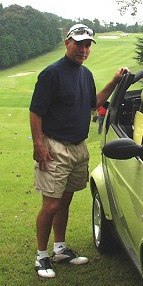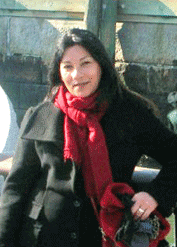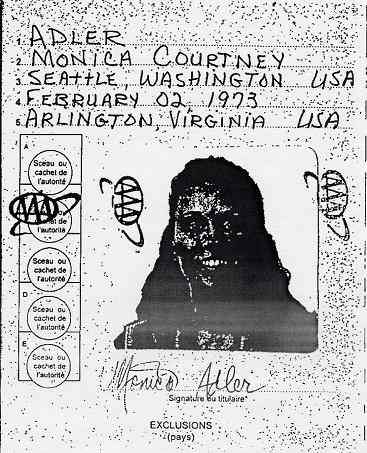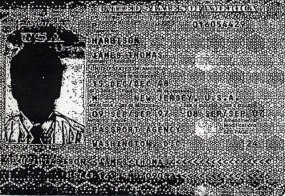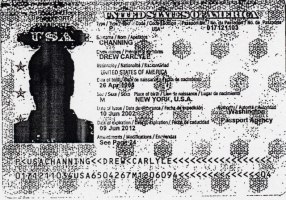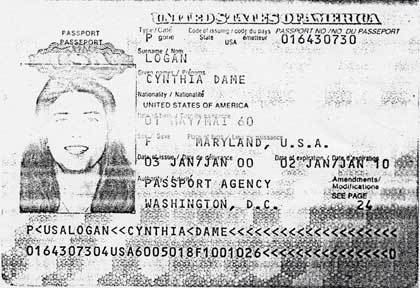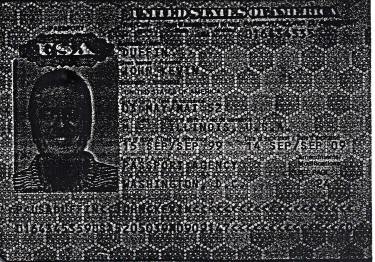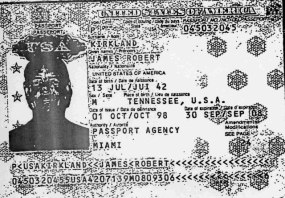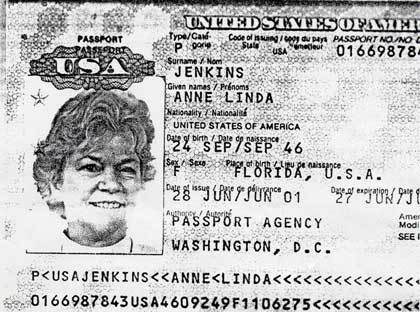 |
Old Bull Lee A Voice From the Reality-based Community Notes from a Study of Things Themselves |
 |
Terrorists vs. Terrorist: A Wrap-up of the Abu Omar Kidnapping Case
 |
Title:
A Kidnapping in Milan/The CIA on Trial Author: Steve Hendricks Publisher: W. W. Norton & Co. Publication Date: 2010 Pages: 317, including 22 for notes.and 13 for an index |
The Abu Omar kidnapping broke into American
headlines in June, 2005. At that time an Italian magistrate--part
prosecutor, part investigator--charged several Italians
and about twenty Americans with violations of Italian law in the
abduction of Osama Mustafa Hassan Nasr, aka Abu Omar. The
incident had occurred more than two years earlier, in Milan on February
17, 2003.
The kidnapping fit the pattern of a CIA "extraordinary rendition." That is, the victim was snatched off a public street and thrown into the back of a van. In seconds his clothes were removed with a pair of scissors, he was drugged will a pill in the anus, dressed in diapers and a jump suit, restrained at the arms and legs, and blindfolded. The vehicle then roared off, headed for a waiting jet plane which would transport him to a distant hellhole where he could expect imprisonment, interrogation, torture and possibly death.
Abu Omar was taken from Via Guerzoni in Milan and driven five hours to Aviano AFB, near Venice. He was loaded on a military Learjet, flown to Ramstein Air Base in Germany, transferred to a leased Gulfstream jet and then flown to Egypt, where he was wanted by authorities because of his association, many years earlier, with Islamic extremists.
Unknown to the CIA, Abu Omar was, at the time he was kidnapped, already under surveillance by Italian police. The Italians knew he'd been kidnapped, but didn't know where he'd been taken. They continued their investigation and kept their wiretap on the phone of Abu Omar's wife, Nabila.
Using cell phone records from the time of the kidnapping, the investigators reconstructed the events of the day. The cell phone records led them to hotel registrations, credit card numbers, frequent flier numbers, auto rental records, and in some cases, photocopies of passports. They also had a solid eyewitness who'd observed the kidnapping from the street.
Their big break came on April 20, 2004, when they intercepted a
phone call between Abu Omar, in Egypt, and his wife, in Milan. It was
clear from the conversation that Abu Omar was in Alexandria. He was not
imprisoned, but was unable to leave the city.
Sixteen months later, Armando Spataro, the Italian magistrate, asked an Italian judge for arrest warrants for the kidnappers. In December 2005 twenty-six Americans and nine Italians were indicted for kidnapping, violating Italian sovereignty and disrupting an ongoing investigation. Where the Americans had used CIA-supplied fake IDs in Italy, the indictments showed their fake names, not their real ones. None of the Americans were in Italy at the time of the indictment.
The trial began in October 2007. The American defendants weren't extradited and they didn't show up for trial voluntarily. The Italians plea bargained or claimed some sort of immunity. The proceedings dragged on until November 2009, at which time twenty-two Americans were convicted in absentia of the charges. Among them were Robert Seldon Lady, one-time CIA chief in Milan; Sabrina De Sousa, a diplomatic official at the US embassy in Rome; and Lt. Col. Joseph Romano III, security chief at Aviano AFB at the time of the kidnapping. Lady was sentenced to eight years in prison and the other Americans got five years.
Background and Context
Kidnapping in Milan tells the full story of the kidnapping incident and its aftermath, filling in details omitted in media coverage and adding explanatory background. The author profiles Armando Spataro and Abu Omar, informs us of the history and modern uses of rendition and torture and tells us of his search for the real identities of the CIA kidnappers. Many readers will be surprised to learn of the Bosnian/Albanian connection to Islamic terrorism in Europe and also of the CIA's long record of covert activity targeting leftist movements in Italy. Particularly interesting is Hendricks' account of his 2007 interview with Abu Omar in Alexandria.Armando Spataro
The book's hero is magistrate Armando Spataro, who's been described as an "Amerophile." Spataro has traveled extensively in the US, particularly likes the city of Chicago, admires the US Constitution and is fond of quoting former Supreme Court Justice Sandra Day O'Connor, who wrote, "we cannot fight tyranny with the instruments of the tyrants." He says he is not fighting Americans, he is fighting lawlessness.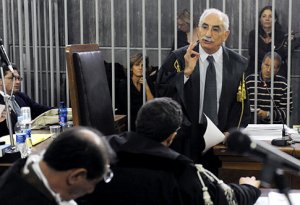 |
| Armando Spataro |
Spataro's remarkable career reminds us that Italy was successfully prosecuting terrorists long before the 9/11 attack and George W. Bush's "War on Terror." It also reminds us that Italy not only had a terrorism problem as bad as America's--terrorists had murdered an Italian prime minister--but also a frightening problem with Mafia criminality. It is important to note that Italy chose to fight terrorism and the mafia by the rule of law, not by violating the law.
Abu Omar
Osama Mustafa Hassan Nasr was born into an upper middle class family in Egypt in 1963. In his early youth he was attracted to the reformist New Wafd political party, which favored elections, civil rights and human rights. But, distressed by the party's messy politics and power struggles he turned to an extreme version of Islam practiced at some mosques in Alexandria. In his third year of law school there he made an inflammatory speech at his mosque, condemning several public officials by name. He was immediately arrested, harshly interrogated and held without trial for six months. At the end of that term, security officials offered him a job as an informant and told him, if he didn't take the job, his whole family would be jailed. Nasr begged for time, and instead of giving an answer, he fled Egypt for Jordan. In Jordan he couldn't get a decent job, so he left for Yemen, where things didn't work out, either. After several months he moved on to Peshawar, Pakistan.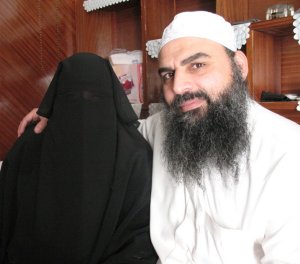 |
| Abu Omar (R) with wife Nabila |
So he moved to Albania because of its large Muslim population. There he worked a while for Saudi-financed humanitarian organization, tried his hand at running a small business and married a local girl seventeen years his junior. His wife bore him a son named Omar, giving Nasr the right to call himself "Abu Omar" or "father of Omar."
After a run-in with the Albanian secret service, Abu Omar moved on to Germany, where he divorced his wife in the Muslim style and sent her and their two children back to Albania. In May 1997 he took a fast train to Rome, where he asked for political asylum because of his persecution in Egypt. The Italians accepted his application and allowed him to stay in Italy while they processed it. (Abu Omar got his political asylum in February, 2001.)
By the summer of 2000 Abu Omar was living in the large Muslim community in Milan. He refused to assimilate or learn the Italian language. He was active at the mosque on Viale Jenner, which was under police surveillance because it had been, several years earlier, the base of operations of master terrorist Anwar Shaaban. Shaaban had left Italy to lead Muslim fighters of Bosnia in their war against Serbia. He'd been killed in Croatia in 1995. Before he'd had left Milan, Shaaban had managed a huge documentation factory that created fake travel papers for Islamic terrorists worldwide, probably including Ramzi Yousef, who organized the 1993 World Trade Center bombing.
Abu Omar became deputy chief imam at the mosque on Viale Quaranta, a spin-off of the mosque on Viale Jenner. He delivered passionate sermons there. Themes were "the sins of the West, the sycophantic Arab governments that did the West's bidding, and the Muslims who did not submit to the one true Islam." Abu Omar married his second wife, Nabila Ghali, an Egyptian, at the Viale Quaranta mosque.
In early 2002 the Italian police placed a bug in the Abu Omar's office at Viale Quaranta. Recorded conversations from this bug plus other surveillance convinced the Italians that Abu Omar was a major recruiter for the Ansar terrorist network, which operated in Kurdistan. But before the Italians could gather enough evidence to support an indictment, Abu Omar was kidnapped by the CIA.
In 2007 Steve Hendricks interviewed Abu Omar in Alexandria. Hendricks found his subject living in a well-maintained apartment in a neighborhood "less shabby than most in town." Before they met, Abu Omar demanded payment for an interview and Hendricks reluctantly agreed to pay $400 for several interviews over several days. (Hendricks later learned that other reporters had paid much more.)
Earlier reports had suggested that Abu Omar was a broken man, disabled mentally and physically by months of torture. Hendricks noted that Abu Omar walked up four flights of stairs with no trouble and was able to talk coherently about his experiences. He did, however, complain about joint pain, depression, difficulty concentrating, and waking up screaming. In the first night's interview Abu Omar described his kidnapping and ordeal in the Egyptian prison. On the next night he gave Hendricks some superficial answers to questions about his involvement with the Albanian secret police and abruptly terminated the interview. Overall, Hendricks was unsure of Abu Omar's veracity. The conflict over money suggested Abu Omar was in desperate financial straits, more concerned with getting paid than telling the truth.
The Americans
All of the Americans had left Italy by the time the trial started. Spataro tried to get them extradited, but Prime Ministers Silvio Berlusconi, and later Romano Prodi, refused to issue extradition papers. So the convicted Americans are safe from Italian justice so long as they stay out of EU countries.The individuals listed below were sentenced to five years, with two exceptions. (1) Jeff Castelli, CIA chief in Rome, was acquitted because of his diplomatic immunity, and (2) Bob Lady was sentenced to eight years because of his central role in the Milan operation.
Hendricks says he was able to determine the actual identities of more than half of the kidnappers who had used fake passports. He doesn't tell readers their real names, though.
The Military Connection
|
Kidnapping role: Chief of security at Aviano Air
Base. Aftermath: He returned to the Pentagon, where he was promoted to full colonel. His lawyer called the Milan verdict, "an embarrassment to Italy." |
The CIA Officers
| Jeff Castelli |
Kidnapping role: CIA station chief for Italy at the time of
the kidnapping. Aftermath: The court found him not guilty because of his
diplomatic immunity. The prosecutor had asked for a sentence of
thirteen years. Before the trial Castelli returned to the US, where he got a promotion from the CIA. After he was outed by Spataro's investigation, his career was over and he quit. He eventually took a private sector job with a company that analyzes propaganda for the US government. From Hendricks' narrative Castelli comes off as an ambitious
man who got the rendition plan approved at higher levels, then pushed
the dirty work off on Bob Lady, who thought it was a bad
idea. |
||
|
Kidnapping role: As Milan CIA chief, he was the
principal coordinator of the rendition. He recruited an Italian
policeman, Luciano Pironi, to stop Abu Omar in the street so that he
could be snatched by the American kidnappers. Aftermath: He fled Italy after the kidnapping was exposed, abandoning his Italian retirement villa before it was seized to pay court costs of €1.5 million. Of all Americans involved he seems to have suffered the most personally. Even his wife left him. |
||
|
Kidnapping role: Her cover was "Second
Secretary" at the US
Embassy in Rome. She appears to have been some sort of liaison between
the embassy and the Milan consulate. Aftermath: She sued the State Department for not providing her with a legal defense or giving her diplomatic immunity. Then she sued Bob Lady and Jeff Castelli for getting her into the mess in the first place. |
The Muscle, The Scouts and the Drivers
|
Kidnapping role: Probably a lookout. She stayed
in five-star hotels and ran up lodging bills in excess of $13,000. She is a Phi Beta Kappa graduate of the "flagship" college in her home state, where she majored in international relations. After graduation she moved to a Washington, DC suburb. A year and a half after the kidnapping she got married to an intelligence analyst and two years after that had a baby. Update 12/27/2014: "Adler" has been exposed as CIA Officer Caren Krystopolski. |
||
| "Gregory Asherleigh" | Kidnapping role: Scout. Two months after the Abu Omar kidnapping he flew to Oslo, Norway, probably to scout the kidnapping of Mullah Krekar, who had some connection to Kurdistan terrorists. That rendition was aborted because the victim's lawyer found out about the plot from Norway's intelligence service. In Italy he listed his address as a residence in Massachusetts belonging to his mother. Hendricks says "Asherleigh" is "tall, just a bit jowly, attractively silver-haired, and devoutly Christian." Also, "Asherleigh" gave money to the Republican Party and lived steps away from a large military base. |
||
| "Raymond Harbaugh" | Kidnapping role: Co-leader of the muscle group;
go-between between Lady and the other kidnappers. |
||
|
Kidnapping role: He was in Abu Omar's
neighborhood at
the time of the kidnapping. Update 12/4/2013: "Harbison" has been identified at the Cryptocomb website as a CIA employee named Thomas James Sullivan. |
||
| "Ben Amar Harty" | Kidnapping role: In Abu Omar's neighborhood at
the time of
the kidnapping. |
||
| "George Purvis" | Kidnapping role: Apparent co-leader of the
kidnapping. Update 12/4/2013: Cryptocomb website reports "George Purvis" is his real name. |
||
| "Pilar Maria Rueda" | Kidnapping role: In Abu Omar's neighborhood at
the time of
the kidnapping. |
||
| "Joseph Sofin" | Kidnapping role: In Abu Omar's neighborhood at
the time of
the kidnapping. |
||
| "Lorenzo Gabriel Carrera" | Kidnapping role: In the caravan that took Abu
Omar to Aviano. |
||
|
Kidnapping role: In the caravan that carried Abu
Omar from Milan to Aviano. |
||
| "Vincent Faldo" | Kidnapping role: In the caravan that took Abu
Omar to Aviano. |
||
|
Kidnapping role: Was in the caravan that carried
Abu Omar from Milan to Aviano. Two months after the Abu Omar kidnapping she flew to Oslo, Norway, probably to scout the kidnapping of Mullah Krekar. That rendition was aborted because the victim's lawyer found out about the plot from Norway's intelligence service. |
||
| "Michalis Vasiliou" | Kidnapping role: Was in the caravan that took
Abu Omar to Aviano. |
||
| "Eliana Isabella Castaldo" | Kidnapping role: Helped scout the abduction. |
||
| "Victor Castellano" | Kidnapping role: Helped scout the abduction. |
||
|
Kidnapping role: Helped scout the abduction. Update 12/27/2014: "Kevin John Duffin" is his real name, according to Cryptocomb. |
||
| "John Thomas Gurley" | Kidnapping role: Helped scout the abduction. |
||
| "Brenda Liliana Ibanez" | Kidnapping role: Helped scout the abduction. |
||
|
Kidnapping role: He was one of the
earliest-arriving kidnappers in Italy. Probably a scout. "Kirkland" has a background in law enforcement and has been a consultant in a private security service. Hendricks interviewed him at his colonnaded ranch house on substantial acreage in a region where "cottontails and Pentecostals were thick on the ground" (Texas?). Kirkland found the film Vantage Point compelling and urged Hendricks to see it. Vantage Point is about a resourseful federal agent who saves Western civilization from destruction by swarthy terrorists. Although Kirkland's Italian cell phone records showed he'd made numerous calls to the woman now his wife, he denied being "Kirkland." Update 12/4/2013: Cryptocomb website reports Kirkland's real name is Robert Davenport. He was an FBI agent for 25 years and now lives in Kentucky. |
||
|
Kidnapping role: Helped scout the abduction. |
Post-publication Developments
December 15, 2010. An appeals court in Italy affirmed the convictions of Americans in the Abu Omar case. The court also increased the five year sentences to seven years and the eight year sentence to nine years.December 17, 2010. Germany's Der Spiegel website reported that once-secret 2006 diplomatic cables reveal that the US government pressured Italy's prime minister to suppress any extradition orders for Americans caught up in the Abu Omar rendition investigation. From Der Spiegel:
"At first, the efforts were conducted via diplomatic channels. But, later, they also took place during top-level talks with Italian Prime Minister Silvio Berlusconi. American diplomats and even the US secretary of defense were assured that the Italian government "was working hard to resolve the situation." And they also got to hear Berlusconi vent his rage at his own country's judicial system.
"These anecdotes come from secret dispatches from the US Embassy in Rome, and they are particularly embarrassing for Berlusconi, who recently survived a confidence vote in parliament. The documents provide detailed descriptions of how both the American ambassador and US Secretary of Defense Robert Gates exerted direct pressure on the Italian government in Rome. In particular, they wanted to make sure that Rome would use its influence to make sure that no international arrest warrants were issued for the CIA agents accused of being involved in Abu Omar's abduction."
Final Thoughts
The CIA is authorized to violate criminal laws of all foreign countries. It is, by its own policies and practices, an international criminal organization. The fact that it operates in secrecy means it remains unaccountable unless its operations are exposed, as occurred in the Abu Omar rendition. The existence of an unaccountable criminal organization within the US government is antithetical to our principles of the rule of law within a constitutional democracy.After the 9/11 attacks the US declared a war on terror. George W. Bush and his administration used the word "war" to curtail civil liberties in the US and unleash all manner on death and destruction abroad. Also, Bush's war on terror enriched his political allies in the military-industrial-intelligence complex at great expense to US taxpayers. Blowback from Bush adminstration policies has made Americans less safe, less free and less rich.
It would have been cheaper and more effective to combat terrorism by treating terrorists as criminals rather than enemies. This could have been done without denying citizens their civil liberties. Steve Hendricks' Kidnapping in Milan shows that terrorism can be fought by western countries without going outside the law. And it illustrates that terrorism committed by the CIA differs little from terrorism committed by militant Islamists.
